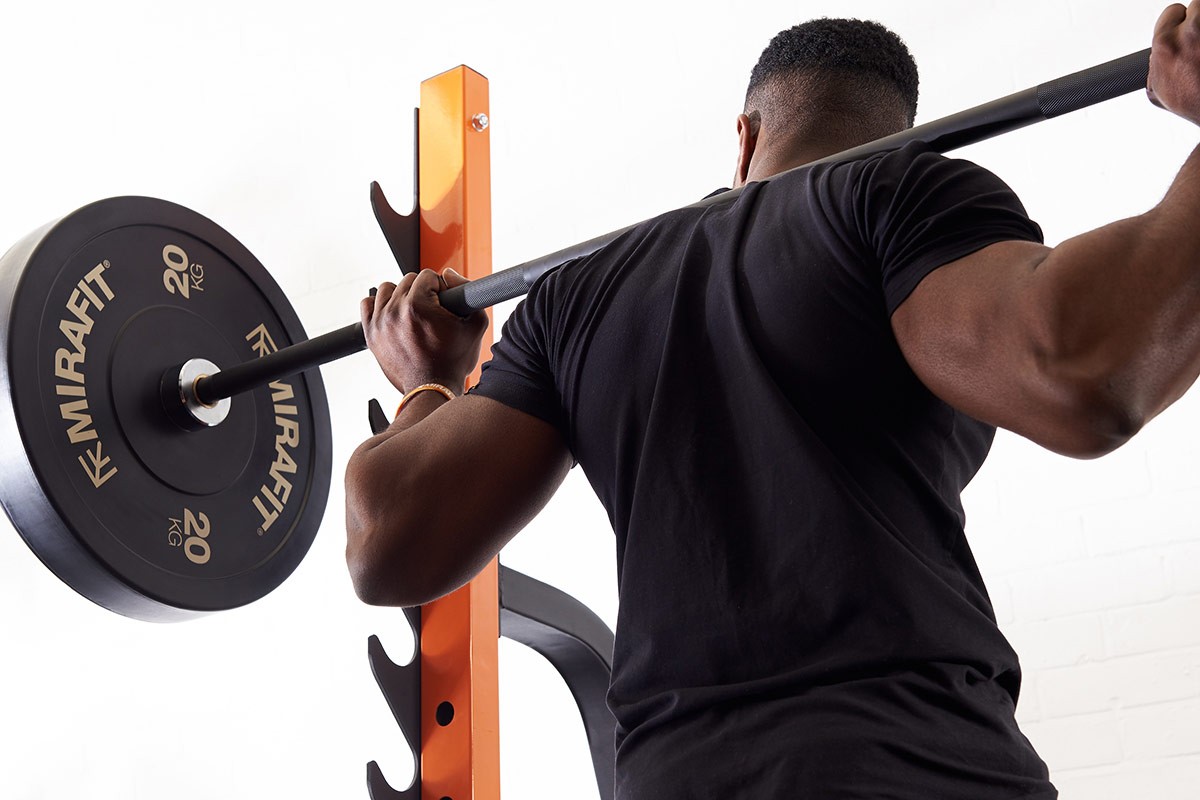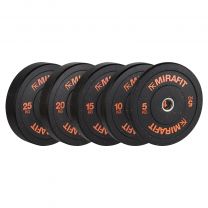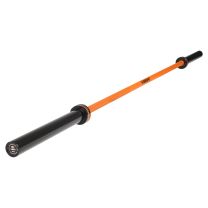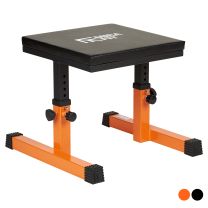Types of Squats
Types of Squats

When you're not using a barbell, there are lots of different ways to squat. And although these variants are great for general fitness, they’re not quite what you want when looking to build some serious muscle.
And even though traditional back squats are key for strength and size, it is vital for progression to vary your exercises – while still working the same muscles.
By mixing things up, you’ll be able to keep your body guessing which will in turn, encourage it to adapt and grow.
So, what are the different types of barbell squat?
Below, we go through all the different types of squats you can do using either a Squat Rack or a Power Rack. Both of which you can find at the gym, or train with at home.
Squat variations
Different types of squats do different jobs. They work slightly different muscles with varied intensity. They also focus specific areas – great if you’re training out your imbalances. And in addition, you’ll find there are squats designed specifically for helping you push past your one-rep max.
So, if you’re looking to start mixing up your training, check out our favourite squat variations below.
1 - Box squats

What are they?
Quite literally, doing squats with a Squat Box behind you. The box can be set at specific heights so you can keep an eye on your squat depth. The seat is also designed to take up to 400kg.
Why box squat?
Box squats break the Stretch-Shortening Cycle. This means you don’t get the added push from your muscles to help you back out of the squat. By breaking the cycle, you’re giving your body enough time to re-set. Getting up from the squat box is much more difficult than maintaining the momentum and pushing straight back up. This ultimately means when you return to traditional back squats, you’ll be stronger.
Another benefit is that the squat box allows you to push your weight back more, so you can emphasise your weight load down your posterior chain. If you feel unsteady while doing free-squats, you won’t be able to progress until you start to inch the weight back. By doing this, you will give your knees a break – ideal if you squat large weight loads regularly. You'll also start to strengthen your stabilising muscles. Work on your flexibility and you’ll have a deeper, stronger squat.
Common mistakes
• The box is designed to allow you to sit back and break the Stretch-Shortening Cycle. It’s not there to allow you to relax your muscles. The objective is to keep your spine straight and your muscles tense as you touch the seat with your hamstrings.
• The box shouldn’t be too high. It’s not a seat so we’re not looking for a classic chair height. You want to develop your posterior chain so make sure you’re going as deep as you can, without any joint discomfort. If you start breaking into good mornings then you need to raise the squat box slightly and work on your hip and ankle mobility, as well as your lower back strength.
• The weight trajectory for box squats is slightly different from the classic squat. With a box squat the bar moves down and then back. Whereas with a classic squat, the weight path goes straight down. As you build back up to doing squats without the box but with a heavier weight, pause at your full squat depth. Hold it for five seconds, and then push back up. This will not only allow you to break that Stretch Shortening Cycle, but it will also help you to re-engage your knee and ankle joints.
2 - Pin squats

What are they?
This is a partial squat done in the power cage or squat rack. The weight load is slightly higher than your one-rep max (by about 2-5kg) and the safety bars are set at your half-squat position.
They’re meant to be performed after you have warmed up but not at the end of a training session.
Why pin squat?
We know half squats on their own aren’t going to improve your squat strength. However, by lifting a heavier weight, you are preparing your nervous system for the next level. This is known as supramaximal stimulus and is used by trained lifters to squat heavier weight loads.
Common mistakes
• Pin squats can be difficult. So, it’s important you’re confident with your technique before you try these. Lifting more than five-ten pounds over your one-rep max can be dangerous and leave you at risk of injury. Know your weights and don’t try to lift too much.
• Pin squats are not to be done until failure. You’re looking to do no more than four reps in each set. Don’t lift too much when you’re fatigued and don’t try these if you have any niggling injuries.
• Like the box squat, pin squats are also a way of breaking the Stretch-Shortening Cycle. When you squat down into the partial squat position, make sure the bar weight rests on the safety bars. This will help with hypertrophy and strengthening.
With both types of squats, you are looking to increase your weight. This means added pressure onto all the areas of your body involved in doing squats.
3 - Resistance band squats

What are they?
Resistance band squats aren’t something you want to do without the proper equipment. However, by using a pair of proper strength Resistance Bands along with some Resistance Band Pegs, you will be able to set yourself up properly.
They are basically just back squats but with resistance bands wrapped around each end of the barbell.
Why do resistance band squats?
By having strength bands wrapped around the ends of the barbell, you instantly make the move more difficult. However, only around the top end of the exercise. So, they’re not as difficult as adding more weight, but they will challenge you at the easier parts of the movement. They’re mainly used for progression and can really help you push through a plateau.
Common mistakes
- A lot of people underestimate just how much more difficult their squats are going to be with the simple addition of a couple of resistance bands. Start off low and adjust your weight as you go.
- We shouldn’t have to say it but we’re going to say it anyway. Make sure that you use a pair of bands – one for each end. You also need to make sure they’re on securely. If you’re new to doing squats with resistance bands, get a training partner to help you the first few times so you can get the hang of things.
- When using resistance bands, it’s common to have to alter your squat cadence to a slower pace. Resistance band squats are strength focused. So, in order to build strength, you’re going to want to slow your squats down. This means you’ll be able to focus on the quality, tension and muscle-tearing benefits these exercises are going to give you.
4 - Chain squats

What are they?
Chain squats are similar to resistance band squats but more difficult. They add extra weight to your back squats, but more so near the top end of the exercise. As you go lower down, the chains rest on the floor so there’s less of a strain at the lowest point of your squat. As you push back up again, you gradually take the weight of the chain back, so the bar is heavier.
Why do chain squats?
Chain squats are great for building strength. And Olympic Barbell Weighted Chains on their own can also be used for a variety of exercises so they’re really versatile.
Common mistakes
- Weighted chains add on an extra 16kg, 24kg or 32kg. So, it’s really important you adjust your barbell weight load to compensate.
5 - Pause squats

What are they?
Pause squats involve holding your squat at full squat depth for anything around 1-3 seconds. Some people pause for longer but a three second pause is the most common. This is a technique use to help build strength and is usually done as an accessory movement.
Why do pause squats?
Pause squats help you to build strength and are another way to eliminate the Stretch-Shortening Cycle. This means your lifts are built on strength rather than momentum.
Common mistakes
- Don’t alter your technique for pause squats. They’re meant to help you with your traditional back squats. So, keep the same posture and bar path to help you make sure you build in the right areas.
- Don’t go down too slowly. Sometimes with pause squats, people feel like they need to go down slowly, hold and then come up slowly. But this will mess up your breathing. Take a deep breath, go down, pause then push back up releasing at the top. Your breath is needed to push back on the pressure of the weight. So, don’t take too long to reach full squat depth.
- Also, remember to keep your pauses consistent. This means pausing for the same amount of time each time you go down. Use a timer or a clock if it helps as it’s quite common for silent counting to speed up when you’re in pain.
6 - Safety bar squats

What are they?
These are standard back squats but done with a Safety Squat Bar. They ease the pressure on your shoulders and can be more comfortable to use. They also neutralise your grip so there’s less strain on your wrists and elbows.
Why do safety bar squats?
Safety squat bars are ideal for doing squat progressions so strength training and accessory lifts. They’re also suitable for doing heavy, maximum load lifts.
Common mistakes
- The most common mistake with this bar is to cheat and let the bar sit back too far with your hands up high. Either that or people have the handles pressed against their chest so that the bar rests on their neck – which is also bad form. The handles should be pointing down, but just watch the bar angle and check that it’s in line with the top of your traps.
- Another point to remember is to make sure your grip doesn’t move around as you squat. So, don’t push down on the handles as you come up.
What muscles do squats work?
Different squats focus slightly different areas. For example, back squats focus your posterior chain, front squats focus your core and quads. The main thing to remember is that squats primarily work your quads. A lot of people think that they are a glute exercise – but this isn’t 100% right.
If you are looking to work your glutes, exercises such as barbell hip raises are much better for working this area.
How do you start squatting with weights?
As one of your heaviest lifts, squats should always be done with correct form. And form should always come first, above weight load. This means practising with a Technique Bar and then moving onto just using an unloaded bar before you start adding any weight.
An 7ft Olympic Barbell weighs between 17kg-20kg so you should make sure that you’re comfortable with this amount of weight first.
When you start using a bar, you may find that it takes time to get used to the feel and pressure along your shoulders.
Once you are happy with your form – you can start to add small amounts of weight.
Find out more about loading a barbell.
Always use a power rack or a squat rack to ensure you train safely. All of our racks come with spotter bars which will catch the bar if you fail or drop the bar.
What are the best types of squats to do?
This really depends on what stage you’re at. Back squats are traditional squats and the one you want to work on at first.
After you start to build strength, you can start varying your squats and try out some of the strength variations and accessory lifts mentioned above.
There isn’t one route, and everyone is different. Keep training and keep mixing things up to see what works for you.
Moving onto deadlifts? Find out about the different types of deadlifts.
For more content, follow us on Instagram, YouTube, TikTok, and on our official Mirafit Facebook page.
Enter your email to signup to our newsletter
Tags: Equipment > Bars & Weight Plates ; Equipment > Power Racks and Cages ; Equipment > Squat Racks ; Exercise Type - Strength







